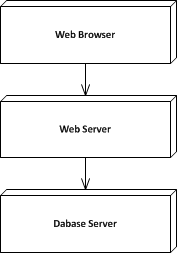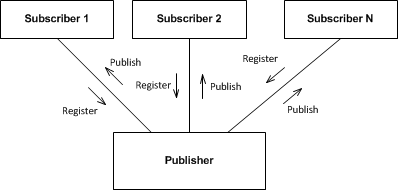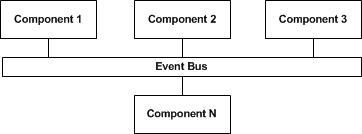Architecture styles
The following is a brief introduction to architectural styles, not intended as a complete reference but as a quick scan-through. For a more complete analysis you might want to read one of the materials referenced at the end of this post.
Layered architecture
The most simple and certainly most known architecture style of is the layered architecture style. There are many examples of the layered patterns applied to IT industry such as the OSI model consisting of 7 layers describing network architecture. The concept is simple, each layers only interact with the layer below it and delivers services for the layer immediately above. The main advantage of layers is the stratification of concerns that are implemented in a system, making each layer perform a certain area of functions makes the system more simple to understand and easier to maintain. When implemented correctly the upper layers can concentrate on implementing functions needed by its users (eg. business functions) and relay on lower layers to handle the more basic system needs (eg. infrastructure functions). A classical example of a layered architecture is the following:
In this diagram, the user interface layer, responsible for displaying information and handling interaction is using services from the business layer who is responsible with performing actual system functions. The business layer is using services on its own from the data layer who is responsible with storing and retrieving data.
A disadvantage of using this style is the decrease of performance because each call that comes from the upper layer must transit all the underneath layers.
You must balance the advantages and disadvantages of using this style and use it when appropriate. Sometimes, for performance reasons, the calls from an upper layer jumps over an intermediate layer and calls directly a lower layer, to boost the performance.
However this is not good practice and undermines the main advantages of this architectural style: lower complexity and better maintainability.
Pipe and filter architecture
One of the oldest styles of architecture recognized as such is the pipes and filters architecture. This style uses processing components that output same kind of data, named filters, and connections between these components, named pipes. The processing is done by each components using data received through the pipe from the previous component. The filter processing can eventually be done concurrently, as data from a previous filter become available. A very well known system build using this architecture is the Unix command lines but other domains can use this style as well. In the diagram below is an example of an image processing system for noise reduction composed of 3 filters:
The clock stereotype from the image above denotes a real-time component, this enforces the idea that the style can be applied to very different systems. The advantage of this style is that complex systems can be build by combining simple components. Each component receive some data from the its inbound pipe, processes the data and sends the result to the outbound pipe. The components can then be combined in new and ingenious ways reusing much of the existing work. For example, replacing the last filter with a “Noise enhancer” component the result is completely different output. As a drawback the style can only be applied to certain class of systems and the processed data may need to have special characteristics to use the style at its full potential.
Client Server and N-tier architecture
The client server architecture style become very well known when the explosion of internet brought it to common vocabulary. On the internet, a browser (client) responsible with user interaction connects to a web portal (server) responsible with data processing and HTML formatting. There are many examples of client-server architectures and initially it appeared as a result of the need to centralize processing and data to a common location and allow changes of the system to be implemented without modifying the whole system. In a system composed only of desktop clients any modification would presumably require redeployment of all clients, a operation that incurred high costs.
It is not easy to balance the amount of functionality implemented on the server with the ones implemented on client because of the conflicting needs and requirements. For example you would want more processing on client when a fast user interface is desirable but you also want as much processing done on the server so that changes are more easily deployed. The web browser clients, are traditionally thin clients where little or no processing is done except displaying server formatted pages and sending input. But, lately there is a grown tendency to add more processing on the clients, HTML5 being an example of this trend. Another aspect that is hard to balance is the amount of data exchanged between the client and the server. You would want very little data transmitted for performance reasons but however the users might demand a lot of additional information.
N-tier architecture style can be seen as a generalization of the client-server architecture. The style appeared as a result of the need to place a system functionality onto more than one processing node. This style of architecture is supported naturally by the layered architecture and more often than not there is confusion between n-tier and n-layer architectures. As a rule of thumb tier refers to processing nodes while layers refers to the stratification of system functionality. The diagram below is a classical example of a n-tier architecture:
As with layered architecture you need to make a decision regarding the number of tiers balancing the performance, separation of concerns, deployment complexity, hardware etc.
Publisher-subscriber architecture
Publisher-subscriber name come from the well-known newspaper distribution model where the subscribers register themselves to receive copies of newspapers from the publisher. The model works about the same way (well maybe without the payment part) in a software system. Data or messages are distributed to a list of subscribers registered with the publisher. The subscribers can later on un-subscribe and will not receive data or messages in the future.
The diagram below shows a general example of this model:
Database systems are known to implement a publisher-subscriber model for data replication but the model can also be used for exchange of messages. The big advantage of this model is the disconnection of the communication channel from the end points. The subscribers are doing their own bookkeeping by registering and un-registering from the publisher and the former only job is to send data to each subscriber in a list. Dynamic end point management can have many advantages, however, keeping track of the subscribers and the sent data that is pretty involving and adds complexity especially during operation.
Event driven architecture
In event driven architecture the components are completely unaware of the communication end points. Communication is handled by a special component at infrastructure level. This might be seen as an evolution of the publisher-subscriber where instead of registering with a subscriber a component is just receiving all or a filtered set of messages from any component that is using the same infrastructure.
The events are send by a component usually without a determined end point, and any component interested in the type of event can receive it together with the attached data. There are many advantages of this approach like the possibility of adding and removing components without a huge impact on the system, easy component relocation, possibility to extend the messages without impacting the components that are not yet ‘upgraded’ and so on. Of course this does not come for free, using this kind of architecture is not something some can add later but it must be constructed from the beginning. The Enterprise Service Bus off the shelf components try to mimic this model at a higher level and with the promise of interconnecting components that were not specifically constructed to work in a service oriented architecture but with some drawbacks like complexity, tendency for hub-and-spoke architectures and performance issues for high throughput systems.
Other styles
There are many other architecture styles not covered here, such as peer-to-peer, hub-and-spoke, interpreter, etc. For a more comprehensive list check out Software Architecture: Foundations, Theory, and Practice for an introductory list or Pattern-Oriented Software Architecture Volume 1: A System of Patterns for a more comprehensive description.








Comments Off on Architecture styles